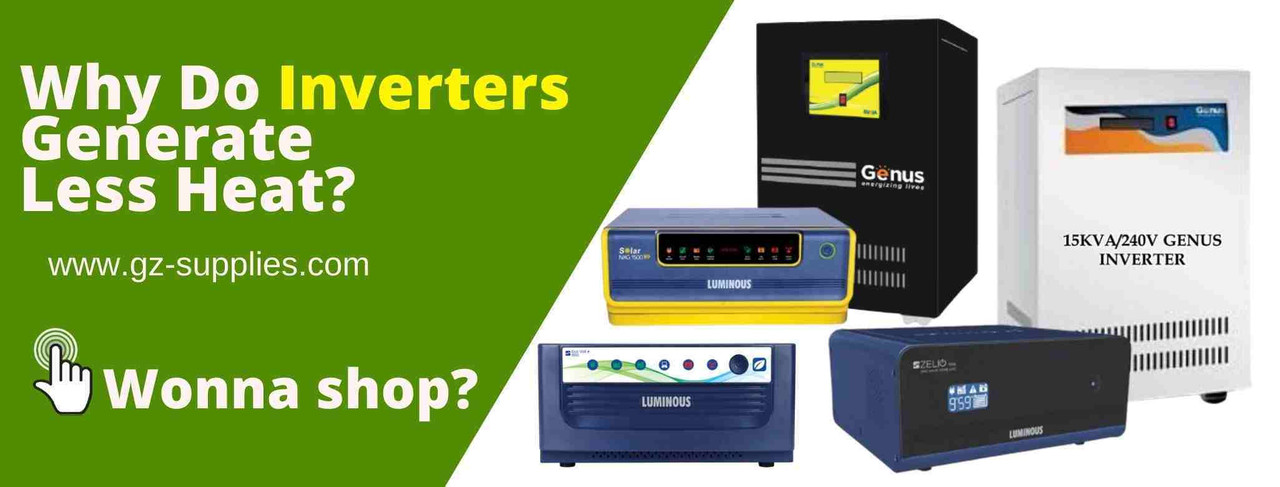Why Do Inverters Generate Less Heat?
A power inverter, or inverter, is a power electronic device or circuitry that changes Direct Current (DC) electricity from sources such as batteries or fuel cells to Alternating Current (AC).
The input voltage, output voltage and frequency, and overall power handling depend on the design of the specific device or circuitry. The inverter does not produce any power; the power is provided by the DC source.
Power inverters are primarily used in electrical power applications where high currents and voltages are present.
How an Inverter Works
An inverter is used to produce an uninterrupted 220V AC or 110V AC (depending on the line voltage of the particular country) supplied to the device connected as the load at the output socket. The inverter gives constant AC voltage at its output socket when the AC mains power supply is not available.
Automation in an Inverter
Inverter contains various circuits to automatically sense and tackle various situations that may occur when the inverter is running or on standby. This automation section looks after conditions such as overload, overheat, low battery, overcharge, etc. irrespective of the situation, the automation section may switch the battery to charging mode or switch OFF. The various conditions will be indicated to the operator employing glowing LEDs or sounding alarms. In advanced inverters, LCD screens are used to visually indicate the conditions.
How Inverters Generate Less Heat
Power generation creates heat, so inverters will get hot. For this reason, it is important to keep your inverter in a location that is cool and dry, and installed in an orientation that will help assist with ventilation (e.g., you are not blocking the intake vents or fans with clothes or tools). If your inverter gets too warm, it will simply shut down until the unit cools down. The hotter your inverter gets, the less AC power it will deliver, hence the new designs that allow for rapid removal of warm air from the inside workings. As the inverter works to convert DC power to AC power, it generates heat. This heat is added to the ambient temperature of the inverter enclosure, and the inverter dissipates the heat through fans and/or heat sinks. The heat needs to stay below a certain level at which the materials in the inverter will start to degrade. Insulation will become brittle, solder can expand, and crack and metal components in capacitors can fatigue.
To keep the heat low, the inverter will stop generating power or reduce the amount of power it generates by reducing the power rating as it passes programmed temperature milestones. Most inverters will derate at around 45 – 50 Degrees C.
Most of the energy transformed by an inverter is dissipated within the active components (transistors, diodes) and inductors (copper and core energy losses).
The amount of energy loss mostly depends on:
- The topology of a given inverter
- Its mode of operation
- Components used
- The cooling system used.
Why is it important for inverters to manage their temperature?
Regulating the temperature of an inverter is less about cooling and more about airflow than one might think. The key to keeping an inverter at the proper temperature is moving the waste heat away from the electronics, rather than blowing cold air at them.
Electronics run most efficiently within a predetermined temperature range, and if not operated within that range, the performance of those electronics will suffer, potentially resulting in a full shutdown and a shortened lifespan of components. This is particularly true for inverters that generate a significant amount of waste heat. Regulating the temperature of an inverter is less about cooling and more about airflow than one might think. The key to keeping an inverter at the proper temperature is moving the waste heat away from the electronics, rather than blowing cold air at them.
How overheating of an inverter is solved
In general, a reputable manufacturer of inverters would have taken care of proper cooling under the rated operating conditions.
If you have your inverter overheated, it is for one of the following reasons:
- Excessive area ambient temperature beyond the specifications: Cool off the room or reduce the load
- Excessive load: Reduce the load
- Improper or blocked ventilation: The fans and filters may be dirty and clogged with dust, the fan is bad, the inlet and outlet may block items or even a sheet of paper. Clean and unblock the airways and add some additional fans blowing across heat sinks if possible.
Kindly Contact us for more information about Inverters.






